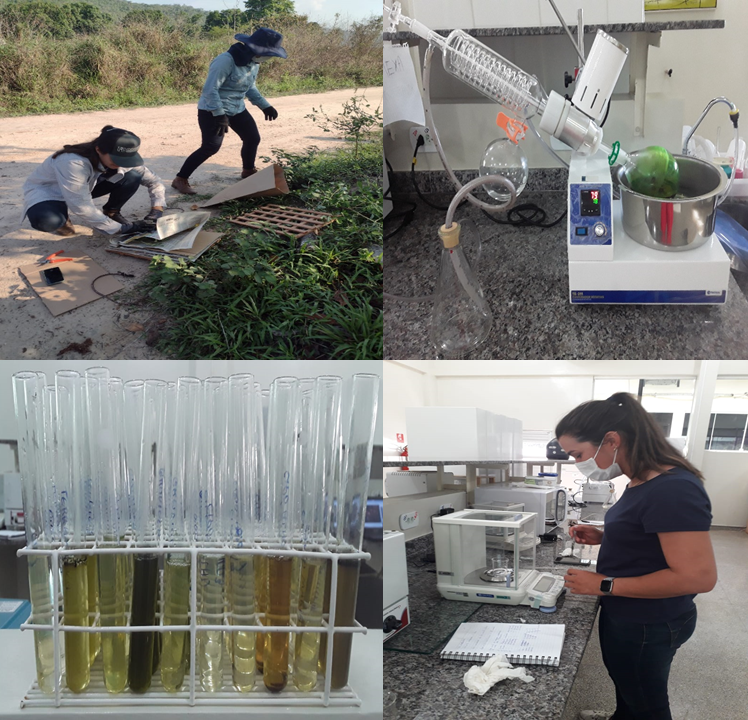Rondoniense flora species potentially active to control parasites in Colossoma macropomum Cuvier
DOI:
https://doi.org/10.54502/msuceva.v2n2a9Palabras clave:
Aquaculture, bioprospecting, botanical families, RFG, Tambaqui.Resumen
Considering the economic importance of the fish sector in Rondônia (in the Western Brazilian Amazon), which has been facing losses due to parasites in production systems, the present study aimed to carry out a survey of genetic resources of the flora of Rondônia, with potential properties to control parasites in Tambaqui, the main native species cultivated in the State. Therefore, based on a semi-structured questionnaire, bioprospecting was carried out in 20 municipalities, which are the largest producers at State level. The collected botanical materials were processed according to conventional herborization techniques and taxonomically determined. A total of 54 plants from the flora of Rondônia (38 determined at the species level, 16 at the genus level), distributed in 49 genera and 30 botanical families, have alleged antiparasitic properties for use in fisheries.
Descargas
Métricas
Citas
Heuer OE, Kruse H, Grave K, Collignon P, Karunasagar I, Angulo FJ. Human Health Consequences of Use of Antimicrobial Agents in Aquaculture. Clinical Infectious Diseases 2009;49:1248–53. https://doi.org/10.1086/605667 DOI: https://doi.org/10.1086/605667
Cabello FC, Godfrey HP, Tomova A, Ivanova L, Dölz H, Millanao A, et al. Antimicrobial use in aquaculture re-examined: its relevance to antimicrobial resistance and to animal and human health. Environ Microbiol 2013;15:1917–42.
https://doi.org/10.1111/1462-2920.12134 DOI: https://doi.org/10.1111/1462-2920.12134
Tavares-Dias M, Lemos J, Martins M, Jerónimo G. Metazoan and protozoan parasites of freshwater fish from Brazil. In: Tavares Dias M, editor. Manejo e sanidade de peixes em cultivo. 1st ed., Macapá, AP: EMBRAPA; 2009, p. 469–94.
Chagas E, Maciel P, Jerónimo G, Tavares-Dias M, Pereira S, Martins M, et al. Doença negligenciada afeta peixes cultivados na Amazônia brasileira. Panorama Da Aquicultura 2016;26:22–9. https://www.embrapa.br/busca-de-publicacoes/-/publicacao/1063722/doenca-negligenciada-afeta-peixes-cultivados-na-amazonia-brasileira
Beli CM, Mageste JM, Taketani NF. Bioprospecção de enzimas para cosmética: Seu impacto na biotecnologia. Revista Ensaios Pioneiros 2020;3:10–24. https://doi.org/10.24933/rep.v3i2.199 DOI: https://doi.org/10.24933/rep.v3i2.199
Albuquerque UP de, Hanazaki N. As pesquisas etnodirigidas na descoberta de novos fármacos de interesse médico e farmacêutico: fragilidades e pespectivas. Revista Brasileira de Farmacognosia 2006;16:678–89. https://doi.org/10.1590/S0102-695X2006000500015 DOI: https://doi.org/10.1590/S0102-695X2006000500015
Albuquerque UP, Medeiros PM de, Ramos MA, Júnior WSF, Nascimento ALB, Avilez WMT, et al. Are ethnopharmacological surveys useful for the discovery and development of drugs from medicinal plants? Revista Brasileira de Farmacognosia 2014;24:110–5.
https://doi.org/10.1016/j.bjp.2014.04.003 DOI: https://doi.org/10.1016/j.bjp.2014.04.003
Chitmanat C, Tongdonmuan K, Khanom P, Pachontis P, Nunsong W. antiparasitic, antibacterial, and antifungal activities derived from a terminalia catappa solution against some tilapia (Oreochromis niloticus) pathogens. Acta Hortic 2005:179–82. https://doi.org/10.17660/ActaHortic.2005.678.25 DOI: https://doi.org/10.17660/ActaHortic.2005.678.25
Chitmanat C, Tongdonmuan K, Nunsong W. The use of crude extracts from traditional medicinal plants to eliminate Trichodina sp. in tilapia (Oreochromis niloticus) fingerlings. Songklanakarin Journal of Science and Technology 2005;27:359–64. http://www.sjst.psu.ac.th/journal/aquatic-suppl-pdf/29-parasite-tilapia.pdf
Tavechio W, Guidelli G, Portz L. Alternativas para a prevenção e o controle de patógenos em piscicultura. B Inst Pesca, São Paulo 2009;35:335–41. https://intranet.institutodepesca.org/35_2_335-341.pdf
Figueiredo H, Leal C, Costa F. O uso de fitoterápicos na Aquicultura. Panorama Da Aquicultura 2011;124:20–5. https://panoramadaaquicultura.com.br/o-uso-de-fitoterapicos-na-aquicultura/
Fujimoto RY, Costa HC da, Ramos FM. Controle alternativo de helmintos de Astyanax cf. zonatus utilizando fitoterapia com sementes de abóbora (Cucurbita maxima) e mamão (Carica papaya). Pesquisa Veterinária Brasileira 2012;32:5–10. https://doi.org/10.1590/S0100-736X2012000100002 DOI: https://doi.org/10.1590/S0100-736X2012000100002
Boijink C, Inoue L, Chagas E, Chaves F. Boas práticas de manejo na piscicultura para conservação da qualidade ambiental: Uso de produtos naturais como anti-helmíntico em tambaqui. Embrapa Amazonia Ocidental 20111;1:41–5. https://ainfo.cnptia.embrapa.br/digital/bitstream/item/48954/1/Doc-88Cheila-A5.pdf
Rodrigues BR, Meurer F, Rogério Boscolo W. Aditivos en la nutrición de peces. Revista Colombiana de Ciencia Animal - RECIA 2015;7:228. https://doi.org/10.24188/recia.v7.n2.2015.286 DOI: https://doi.org/10.24188/recia.v7.n2.2015.286
REFLORA. Brasil de plantas: rescate histórico y herbario virtual para el conocimiento y conservación de la flora y fauna de Brasil. Programa REFLORA Instituto de Investigación Del Jardín Botánico de Río de Janeiro 2022.
Cunha P. Aspectos Históricos Sobre Plantas Medicinais, Seus Constituintes Ativos e Fitoterapia. 2005.
https://www.ppmac.org/sites/default/files/aspectos_historicos.pdf
Zappi DC, Filardi FLR, Leitman P, Souza VC, Walter BMT, Pirani JR, et al. Growing knowledge: an overview of Seed Plant diversity in Brazil. Rodriguésia 2015;66:1085–113. https://doi.org/10.1590/2175-7860201566411 DOI: https://doi.org/10.1590/2175-7860201566417

Descargas
Publicado
Cómo citar
Número
Sección
Licencia
Derechos de autor 2022 Oliveira, Oliveira Queiróz, Cuevas Ferreira, Oliveira Menezes de Sá, Paiva Medeiros, Caetano Nunes Pazdiora

Esta obra está bajo una licencia internacional Creative Commons Atribución-NoComercial-SinDerivadas 4.0.
Magna Scientia UCEVA proporciona un acceso abierto, libre y gratuito a su contenido, basado en el principio de que ofrecer al público un acceso libre a las investigaciones, ayuda a un mayor intercambio global del conocimiento. Lo cual, implica que los usuarios pueden leer, descargar, almacenar, imprimir, buscar, indexar y realizar enlaces a los textos completos de esta revista. Se permite distribuir los diversos artículos en las versiones post-print y oficial, sin previo permiso del autor o editor, considerando que el fin de este, no implica fines comerciales, ni la generación de obras derivadas; Solo se solicita la mención de la fuente así como la autoría. El titular del copyright será el o los autores que publiquen en Magna Scientia UCEVA.
Magna Scientia UCEVA está distribuida bajo los términos de la licencia https://creativecommons.org/licenses/by-nc-nd/4.0/deed.es




















